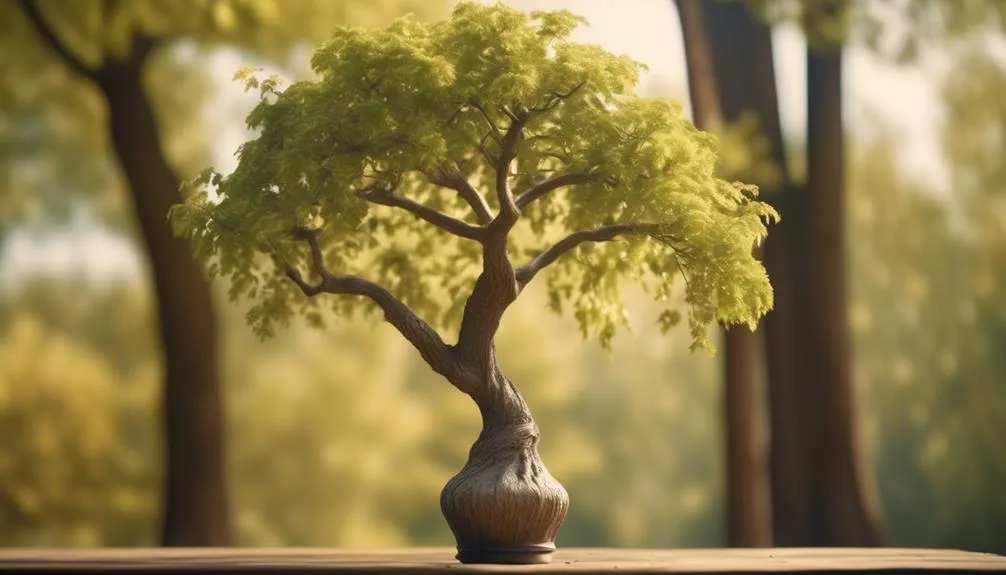Elm trees often catch our eye with their elegant, vase-shaped crowns as we walk through parks or forests. Their branches gracefully arch out, creating a striking outline against the sky.
But why do elm trees grow like this? It's not just for looks. There are interesting reasons behind their unique shape that go beyond aesthetics. Understanding the science behind this can reveal the impressive adaptability and resilience of these magnificent trees.
Elm Trees' Growth Pattern
As elm trees mature, their growth pattern displays a graceful upward reach, creating a striking silhouette in the landscape. Elm trees are known for their moderate to fast growth rate, with some species growing up to 3 feet per year under optimal conditions.
This rapid growth contributes to the development of their vase-shaped crown, characterized by a broad, spreading canopy and a narrower central leader. The crown development of elm trees is influenced by their growth rate, as the upward growth of the central leader is balanced by the lateral growth of the branches, resulting in the distinctive vase shape.
This growth pattern not only enhances the aesthetic appeal of the tree but also provides ample shade and shelter for various wildlife. Understanding the growth pattern of elm trees is crucial for proper care and maintenance to ensure their health and longevity.
Environmental Adaptation
In order to thrive in diverse habitats, elm trees adapt to varying environmental conditions, showcasing remarkable resilience and versatility. These trees have the remarkable ability to adjust their canopy coverage, allowing them to thrive in both open and dense woodland areas.
Elm trees play a crucial role in maintaining ecological balance by providing extensive canopy coverage, which offers shade and shelter to various wildlife species. Their adaptability also enables them to withstand harsh weather conditions, making them valuable contributors to the ecosystem.
Elm trees provide numerous ecological benefits, including the preservation of soil moisture and the prevention of erosion. Their adaptive nature not only ensures their survival but also enhances the overall health and biodiversity of the environments they inhabit.
Structural Strength
With its robust and resilient trunk and branches, the elm tree exhibits exceptional structural strength, making it well-suited for enduring various environmental challenges. The structural stability of elm trees is a result of their architectural design, which includes the following key features:
- Interlocking Grain: Elm trees possess interlocking grain patterns in their wood, providing them with natural resistance to bending and breaking.
- Flexibility: The flexibility of elm wood allows it to withstand strong winds and heavy snow loads without snapping.
- Heartwood Formation: The gradual formation of heartwood in the core of the trunk enhances the tree's structural integrity over time.
These structural characteristics contribute to the elm tree's ability to thrive in diverse environmental conditions, making it a symbol of resilience and durability in the natural world.
Wind Resistance
The elm tree's remarkable wind resistance is a testament to its flexible yet robust nature, allowing it to sway and bend gracefully in the face of strong winds without succumbing to breakage. This exceptional ability stems from the tree's biomechanics and unique architecture.
Elm trees have evolved to withstand wind through their flexible wood and efficient canopy dynamics. The tree's trunk and branches are designed to distribute the forces of the wind evenly, reducing the risk of structural failure.
Furthermore, forest management practices often leverage the elm tree's wind resistance. When planted strategically, they can act as natural windbreaks, helping to protect other trees and crops from wind damage.
Understanding the wind resistance of elm trees is crucial in shaping sustainable forest management strategies and maintaining the health and resilience of woodland ecosystems.
Aesthetic Appeal
Exuding an elegant and graceful presence, elm trees captivate with their sweeping branches and symmetrical vase-shaped crowns, adding a timeless beauty to landscapes and urban settings alike. Their aesthetic appeal goes beyond mere visual pleasure, playing a crucial role in landscaping design.
Elm trees enhance the beauty of an area, providing a sense of tranquility and grandeur. Their vase-shaped crowns create a striking silhouette against the sky, adding depth and dimension to the surroundings. Whether lining a street or gracing a park, these trees contribute to the overall ambiance, enriching the environment with their natural allure.
Their pleasing form and structure make them a favored choice for landscaping projects, where their beauty becomes an integral part of the design.
- Elm trees bring a sense of elegance to any landscape.
- The vase-shaped crowns add a unique and eye-catching element to outdoor spaces.
- Their beauty enhances the overall aesthetic of urban and natural settings.
Conclusion
In observing the distinctive vase-shaped crown of elm trees, we witness nature's ingenious design for environmental adaptation, structural strength, and wind resistance. This not only ensures their survival but also bestows a natural allure to the landscape.
Next time you venture outdoors, take a moment to appreciate these majestic trees and ponder the remarkable ways in which they harmonize with their surroundings.

My interest in trees started when I first saw the giant sequoias in Yosemite.
I was a teenager then, and I remember thinking, “I need to learn more about this.”
That moment stuck with me.
A few years later, I went on to study forestry at Michigan Tech.
Since graduating, I’ve worked in a mix of hands-on tree care and community education.
I’ve spent over ten years helping people understand how to plant, maintain, and protect the trees in their neighborhoods.
I don’t see trees as just part of the landscape.
They are living things that make a real difference in our daily lives.
